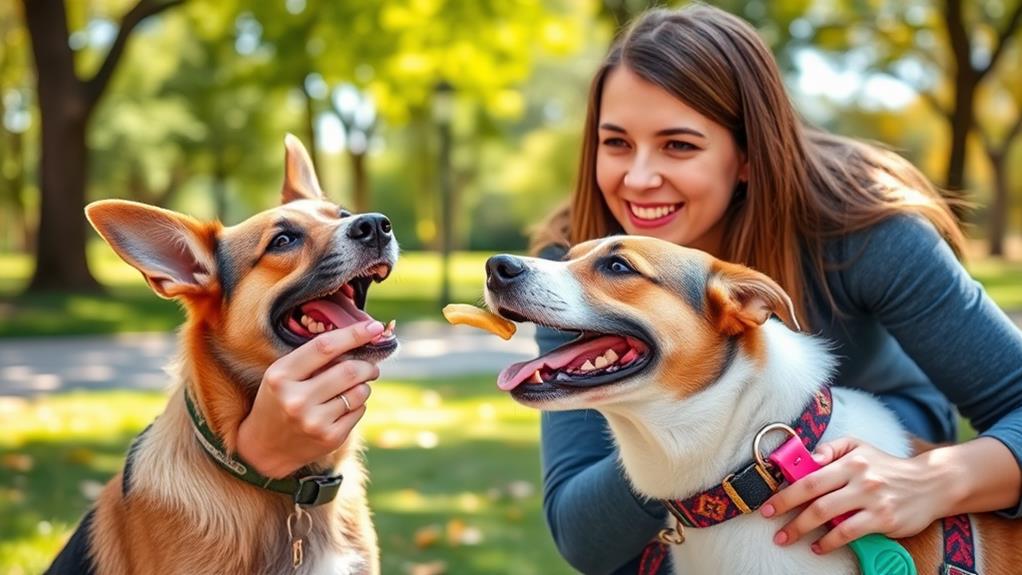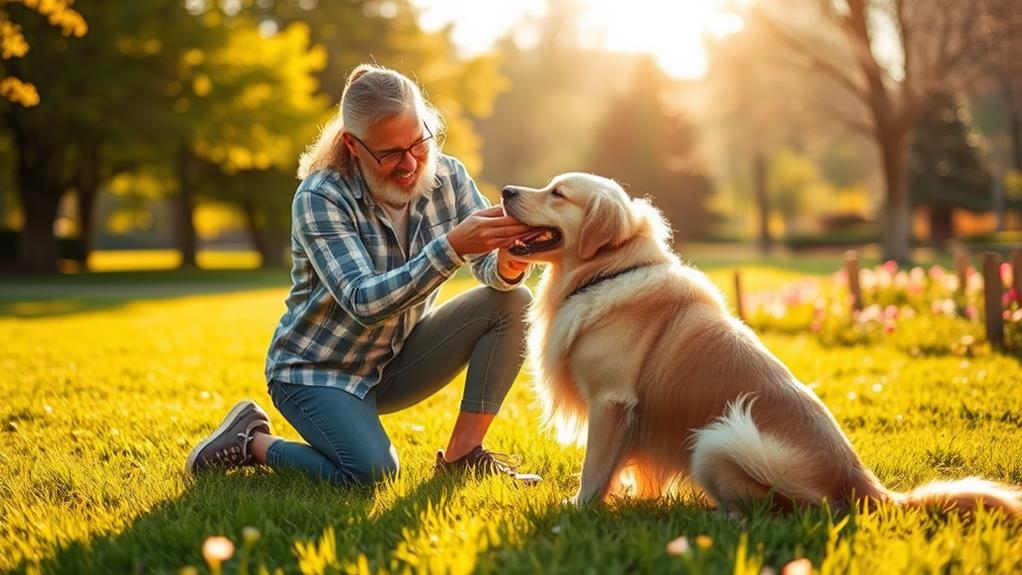To effectively train your dog, you should try three highly effective methods. First, positive reinforcement training focuses on rewarding good behavior with treats or praise, creating a strong connection between actions and rewards. Second, clicker training uses a unique click sound to mark desired behaviors, making it easier for your dog to connect their actions with rewards. Ultimately, relationship-based training emphasizes trust and communication, using affection and play to strengthen your bond. Each method is effective; however, understanding their nuances can enhance your approach as you build a lasting partnership with your furry friend.
Positive Reinforcement Training

Using positive reinforcement training is one of the most effective ways to teach your dog desired behaviors. This method focuses on rewarding your dog for good behavior rather than punishing them for mistakes. When your dog performs a command correctly, you immediately offer a reward, such as treats, praise, or playtime. This approach encourages them to repeat the behavior in the future.
To get started, identify the behaviors you want to reinforce. Whether it's sitting, staying, or coming when called, be consistent with your commands. When your dog successfully follows your cue, reward them right away to create a positive association. This timing is pivotal, as it helps your dog understand what they're being rewarded for.
Be patient and persistent. Not every dog learns at the same pace, so adjust your expectations accordingly. If your dog isn't responding as you hoped, consider changing your rewards or the environment. Make training sessions short and fun, keeping your dog engaged and keen to learn. Remember, the goal is to build a trusting relationship where your dog feels motivated to obey because they know good things come from their efforts.
Clicker Training

Clicker training is a popular method that enhances positive reinforcement techniques. This approach uses a small handheld device that makes a distinct clicking sound to mark desired behaviors. When you click, it signals to your dog that they've done something right, immediately followed by a treat or praise. This clear communication helps your dog understand exactly what behavior you want.
To get started, introduce the clicker to your dog by clicking it and then offering a treat. Repeat this several times so they associate the sound with a reward. Once your dog understands the clicker, begin training simple commands like "sit" or "stay." When your dog performs the desired behavior, click and reward them right away.
Consistency is key in clicker training. Make sure to click and treat for every successful behavior, especially during the initial stages. As your dog becomes more proficient, you can start to phase out the treats, clicking only for the best performances. Clicker training not only helps you teach commands effectively but also strengthens your bond with your dog, as they'll enjoy the fun and interactive learning process.
Relationship-Based Training

At the heart of relationship-based training is the understanding that a strong bond between you and your dog enhances the learning experience. This method emphasizes trust, respect, and clear communication, allowing your dog to feel secure and motivated to learn. Instead of relying solely on treats or corrections, you'll focus on building a connection through positive interactions.
Start by spending quality time with your dog. Engage in activities they enjoy, whether it's playing fetch or going for walks. This helps your dog associate you with positive experiences. When it comes to training, use praise, affection, and play as rewards. Your enthusiasm will encourage your dog to respond and engage more actively.
During training sessions, pay attention to your dog's body language. Understanding their signals can help you adjust your approach and timing, making learning smoother. Remember, patience is key. If your dog struggles, take a step back and revisit the basics.
Frequently Asked Questions
How Long Does It Take to See Results From Dog Training?
You'll typically see results from dog training within a few weeks, but it depends on factors like your dog's age, temperament, and consistency. Stay patient, keep practicing, and celebrate small victories along the way!
Can I Use Multiple Training Methods Simultaneously?
Yes, you can use multiple training methods simultaneously. Just be consistent and guarantee the techniques complement each other. Mixing approaches can enhance learning, but avoid overwhelming your dog with too many commands at once.
What Age Is Best to Start Training My Dog?
You might think it's too early to start training, but the best age is around 8 weeks. At this stage, your pup's brain is like a sponge, ready to absorb new commands and behaviors.
How Do I Handle a Stubborn or Unresponsive Dog?
When handling a stubborn or unresponsive dog, stay patient and consistent. Use positive reinforcement, break tasks into smaller steps, and keep sessions short. You'll build trust and encourage your dog to engage more enthusiastically.
Are There Specific Breeds That Respond Better to Certain Training Methods?
Certain breeds definitely respond better to specific training methods. For instance, herding dogs often excel with positive reinforcement, while stubborn breeds may require more patience and consistency. Tailoring your approach can foster better communication and learning.
Conclusion
Just like a gardener nurtures a seedling with care and patience, you can cultivate a strong bond with your dog through effective training methods. By using positive reinforcement, clicker training, and relationship-based techniques, you're not just teaching commands; you're growing trust and understanding. With time, your efforts will blossom into a beautiful partnership, where your dog thrives and flourishes, keen to learn and satisfy. So, grab that watering can of love and watch your training garden thrive!



